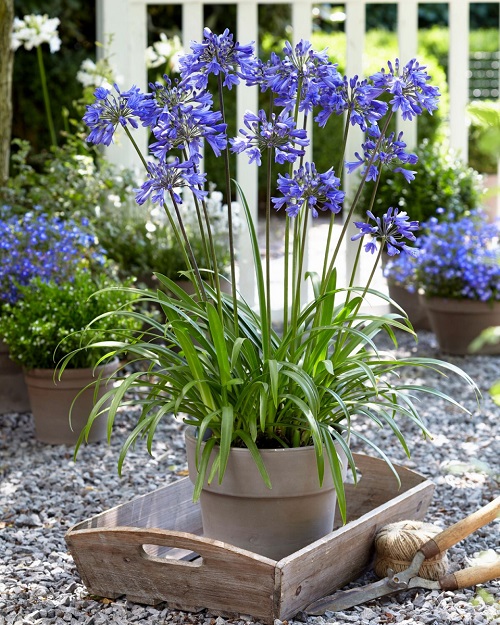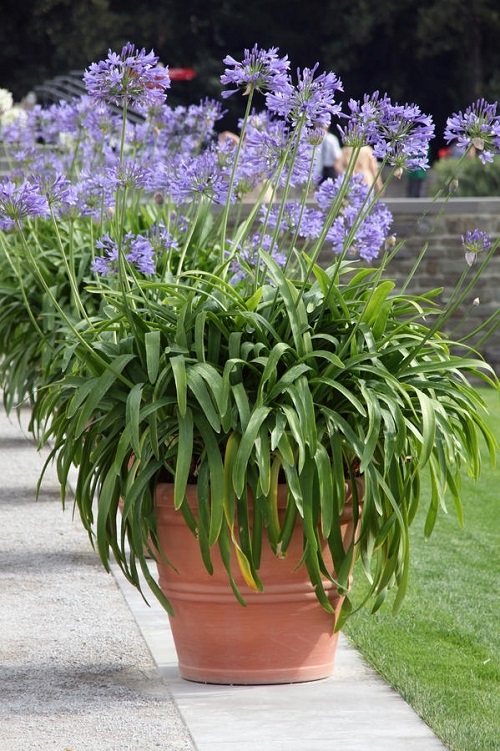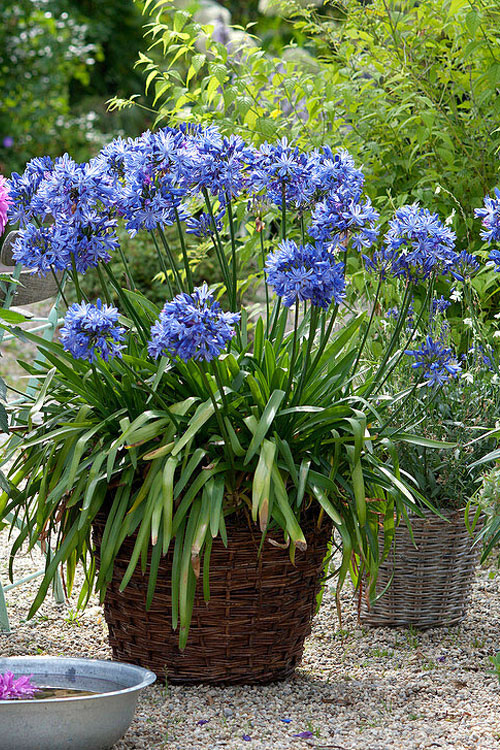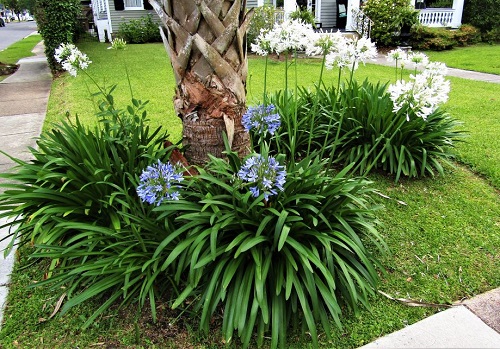Read everything about Lily of the Nile Care and Growing Information and adds a touch of vibrant blue color to your outdoor space.
If you’re looking to add a touch of blue to your garden, consider growing Lily of the Nile These showy and versatile plants are easy to care for and will reward you with their stunning blooms year after year. In this guide, we’ll cover all the basics of caring for and growing Lily of the Nile, from planting to maintenance.
Read about Red Spider Lily Care and Growing Guide here
Lily of the Nile Plant Information
The Lily of the Nile plant is native to South Africa, particularly in the eastern and southern regions of the country. It grows in a range of habitats, including grasslands, forests, and rocky slopes.
The plant is known to have been cultivated in the Cape of Good Hope as early as the 17th century and was introduced to Europe in the 18th century.
The Lily of the Nile plant is a perennial herb that belongs to the Agapanthus genus. It has long, narrow leaves that grow in a basal rosette and can reach up to two feet in length.
It can grow up to four feet in height and produces large, spherical clusters of flowers that can range in color from white to blue to purple. The flowers have a trumpet-like shape and can reach up to six inches in diameter. The plant blooms in summer and can continue flowering for several weeks.
Propagating Lily of the Nile
The division is the most common method of propagating Agapanthus. It is best to divide the plant in the spring, just as new growth begins to emerge. Here are the steps to follow:
- Dig up the entire plant and gently remove any excess soil from the roots.
- Carefully separate the clumps of roots by pulling them apart or cutting them with a sharp, clean knife.
- Make sure that each division has a healthy root system and a few leaves or buds.
- Replant each division in a well-draining soil mix and water thoroughly.
Best Varieties of Lily of the Nile
- Blue Triumphator: It is a popular variety of Lily of the Nile that is known for its large blue flowers. It is a tall plant that can reach up to 3 feet in height and has a spread of about 2 feet.
- Snowball: The flowers of Snowball are slightly smaller than other varieties, but they make up for it in their sheer number. This plant is also shorter than many other varieties, reaching a height of only 18-24 inches.
- Peter Pan: It is a dwarf variety of Lily of the Nile that is perfect for small gardens or containers. It produces clusters of blue flowers that bloom in mid-summer and can reach a height of up to 18 inches.
- Albus: Albus is a white-flowered variety of Lily of the Nile that is perfect for adding a touch of elegance to any garden. It produces large clusters of pure white flowers that bloom in mid-summer.
- Back in Black: It is a unique variety of Lily of the Nile that produces dark purple flowers. It is a tall plant that can reach up to 3 feet in height and has a spread of about 2 feet.
Find How to Fix and Save Overwatered Peace Lily here
Lily of the Nile Pot Size
The pot size for Lily of the Nile can vary depending on the size of the plant and how large you want it to grow. As a general rule, a pot with a diameter of 10-12 inches would be good to start the plant.
Depending on the growth and spread, keep on re-potting it into one size bigger container than the old one.
Requirements for Growing Lily of the Nile
Sunlight
Lily of the Nile requires at least 6-8 hours of direct sunlight every day to bloom and produce healthy foliage. It can tolerate partial shade, but it will not bloom as profusely as it would in full sun.
In areas with hot summers, these flowers may require some afternoon shade to protect it from scorching heat. In contrast, in areas with mild summers, the plant may benefit from more hours of direct sunlight.
Soil
Lily of the Nile is not picky about the growing medium and will do well in sandy, loamy, and clay soils, as long as they are well-draining. It prefers neutral to slightly acidic soil with a pH between 6.0 and 7.0.
Enriching the soil with compost or organic matter at the time of planting will improve the plant’s health and bloom. It helps improve soil structure, drainage, and nutrient availability. Adding a handful of sand to the growing medium will also help.
Water
These plants need regular watering to bloom and grow well. Water Lily of the Nile when the topsoil feels a little dry to the touch. Overwatering can cause root rot, so it’s better to err on the side of too dry rather than too wet.
During the blooming season (summer), water more frequently. The plant is in its growing phase at this time and needs more water to support its growth.
In winter, reduce the watering. The plant goes dormant during the colder months, and too much water can lead to root rot.
Temperature
Lily of the Nile grows best in temperatures ranging from 55°F to 75°F (13°C to 24°C) during the day and 50°F to 65°F (10°C to 18°C) at night.
In colder climates, it is best to grow these plants in containers and bring them indoors during winter months, or provide adequate protection with mulch or frost cloth.
Lily of the Nile Care
Fertilizer
To promote healthy growth, fertilize Lily of the Nile with a balanced liquid feed. diluted to 1/2 of its strength, once in 4-5 weeks. This will give it all the bost it needs to grow bigger and better flowers. Do not feed the plant in colder months.
Deadheading
To encourage prolonged blooming, it’s recommended to deadhead Lily of the Nile by cutting off the faded flowers at the base. However, some individuals prefer to leave the seedheads intact for early winter appeal.
In the fall season, it’s advised to remove the flowered stems and yellowed leaves of deciduous lilies, as they naturally die back. On the other hand, untidy leaves on evergreens can be removed at any point in time.
Overwintering
In the fall, it’s important to safeguard potted Lily of the Nile plants by relocating them to a well-lit, frost-free area, ideally protected from heavy winter precipitation. This could be a cool greenhouse or cold frame or even the bottom of a south- or west-facing wall if other options are unavailable.
It’s advisable to wrap them with two to three layers of Horticultural fleece.
Pests and Diseases
Lily of the Nile is susceptible to various pests, including mealybugs, thrips, and aphids. To prevent infestations, inspect regularly for any signs of pests, such as white cottony masses or yellow spots on leaves, and use insecticidal soap or neem oil to control them.
To keep most of the potential diseases at bay, avoid overwatering and wetting the leaves. Also, make sure the plant gets plenty of air circulation.
Landscaping with Lily of the Nile
- Lily of the Nile is a versatile plant that offers endless possibilities for landscaping ideas. For instance, you could use it as ground cover under trees or shrubs, where it can thrive with moderate sunlight and without competing with nearby plants.
- Alternatively, if you have a water feature such as a pond or stream, you can incorporate these flowers as they love moist soil conditions – just be sure not to overwater them.
- For a unique touch, consider creating living walls by training climbing vines up trellises covered in cascading stems full of vibrant blue blooms.
- Regardless of your style, whether modern or classic, incorporating the lily of the Nile into your landscape design will undoubtedly bring beauty and joy all year round.








I am wondering if you can show pictures of the bulb of the Lily of the Nile. I have some plants in my yard that were here when we purchased our house and I have no idea what they are. Thank you